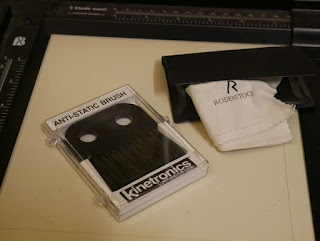Have you ever sat and looked at that shaft of light streaming into the room revealing all those microscopic particles dancing in the air. Then blowing in that direction to watch them swirl around. It always makes me think how is it that our lungs do not fur up like that of untouched dust on a flat surface.
With all those bits hanging around it is a wonder that the film photographer produces any sort of fine-looking photograph. What with having to check and clean inside the back of the camera where the film sits, the camera lens, the film when processed, the enlarging lens, the negative carrier with glass it just wares you out just thinking about it.But we don't think about it seriously enough that is why we end up buying all these lens cloths, antistatic brushes, compressed air cans. The amount of time spent on blowing, wiping and brushing only to end up with more dust stuck to our optical surfaces than when we started. It is a wonder that a picture is produced at all.
The static builds up in us because of the manmade fibers rubbing against our bodies (plastic) acting as an insulator. If you have not earthed yourself, say by washing your hands and or walking around in bare feet. The static continues to build in extreme cases you can get fly away hair. This is where your hair starts to lift up from your head. Before it gets to this point most of us earth ourselves in some way dissipating the static before we get to that shock the car.
Some years ago, I spent a lot of time try to remove some spots of dust from the glass of the negative carrier, having removed it, to have it all come back tenfold as soon as I touched it with my bare hand. The air was blue with my frustration.Slowly the penny dropped I was the problem I was magnetizing the glass with the excessive static in my body. Time to sort this once and for all. I had sitting in a draw an earthing band that I used when building a computer.
The earthing strap was set up by the enlarger where it has remained. It has put in sterling service over the years it's still a wonder, to watch the dust fall off the glass of the negative carrier when I touch it to it. It is also one of the first things I do when entering the darkroom is to touch the earth before I start setting things up.Occasionally you get a stubborn particle needing wiping off but nowhere near as much trouble to remove. Once done a touch to earth again making it ready to load the film that is earthed just before loading.
This article is the copyright of Mitch Fusco 2022 all rights reserved







